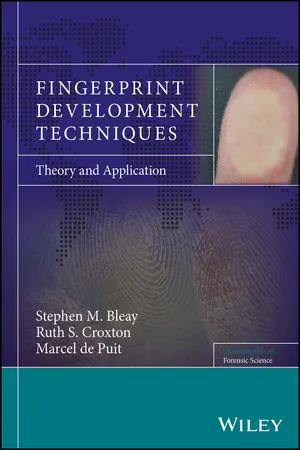
Fingerprint Development Techniques
Theory and Application
- English
- ePUB (mobile friendly)
- Available on iOS & Android
Fingerprint Development Techniques
Theory and Application
About this book
A comprehensive review of the latest fingerprint development and imaging techniques
With contributions from leading experts in the field, Fingerprint Development Techniques offers a comprehensive review of the key techniques used in the development and imaging of fingerprints. It includes a review of the properties of fingerprints, the surfaces that fingerprints are deposited on, and the interactions that can occur between fingerprints, surfaces and environments. Comprehensive in scope, the text explores the history of each process, the theory behind the way fingerprints are either developed or imaged, and information about the role of each of the chemical constituents in recommended formulations.
The authors explain the methodology employed for carrying out comparisons of effectiveness of various development techniques that clearly demonstrate how to select the most effective approaches. The text also explores how techniques can be used in sequence and with techniques for recovering other forms of forensic evidence. In addition, the book offers a guide for the selection of fingerprint development techniques and includes information on the influence of surface contamination and exposure conditions.
This important resource:
- Provides clear methodologies for conducting comparisons of fingerprint development technique effectiveness
- Contains in-depth assessment of fingerprint constituents and how they are utilized by development and imaging processes
- Includes background information on fingerprint chemistry
- Offers a comprehensive history, the theory, and the applications for a broader range of processes, including the roles of each constituent in reagent formulations
Fingerprint Development Techniques offers a comprehensive guide to fingerprint development and imaging, building on much of the previously unpublished research of the Home Office Centre for Applied Science and Technology.
Frequently asked questions
- Essential is ideal for learners and professionals who enjoy exploring a wide range of subjects. Access the Essential Library with 800,000+ trusted titles and best-sellers across business, personal growth, and the humanities. Includes unlimited reading time and Standard Read Aloud voice.
- Complete: Perfect for advanced learners and researchers needing full, unrestricted access. Unlock 1.4M+ books across hundreds of subjects, including academic and specialized titles. The Complete Plan also includes advanced features like Premium Read Aloud and Research Assistant.
Please note we cannot support devices running on iOS 13 and Android 7 or earlier. Learn more about using the app.
Information
1
Introduction
Key points
- The traces left by contact between the hands and other surfaces are an essential tool in forensic investigations.
- Such traces can be used in several ways: to provide contextual information about the contact event and to identify individuals.
- All potential forensic applications of such contact traces rely on them being visualised by some means.



Table of contents
- Cover
- Title Page
- Table of Contents
- Series Preface
- Acknowledgements
- 1 Introduction
- 2 Formation of fingermarks
- 3 Composition and properties of fingermarks
- 4 Ageing of fingermarks
- 5 Initial examination and the selection of fingermark enhancement processes
- 6 Optical detection and enhancement techniques
- 7 Vapour phase techniques
- 8 Solid phase selective deposition techniques
- 9 Amino acid reagents
- 10 Reagents for other eccrine constituents
- 11 Lipid reagents
- 12 Liquid phase selective deposition techniques
- 13 Enhancement processes for marks in blood
- 14 Electrical and electrochemical processes
- 15 Miscellaneous processes: lifting and specialist imaging
- 16 Evaluation and comparison of fingermark enhancement processes
- 17 Sequential processing and impact on other forensic evidence
- 18 Interpreting the results of fingermark enhancement
- Index
- End User License Agreement